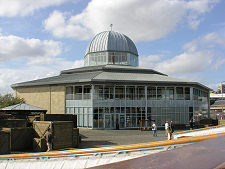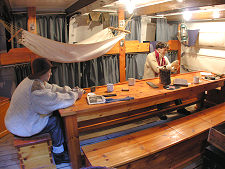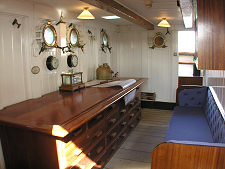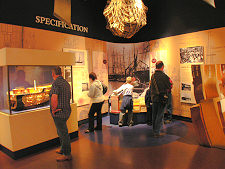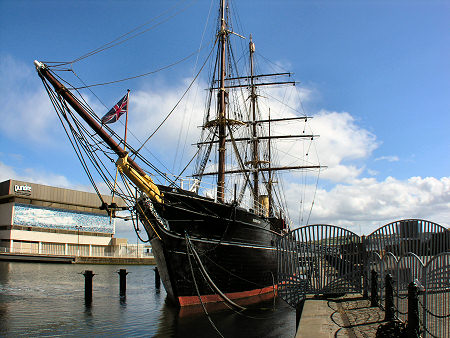 RRS Discovery at Discovery Point |
No visit to Dundee is complete without a visit to Discovery Point on the bank of the River Tay close to the city centre. Here a superb museum in a spectacular building helps tell the interlocking stories of a native of Dundee, the Royal Research Ship Discovery, the man who became famous while in command of her, Robert Falcon Scott, and the continent they were both born to explore: Antarctica.
In the dying days of the 1800s the Royal Geographical Society needed a ship specifically designed to allow the exploration of one of the Earth's last unexplored areas, Antarctica. Much of the UK's whaling fleet at the time was built and based in Dundee, and it was to the Dundee Shipbuilders' Company that the RGS turned to produce their ship.
Work started in March 1900 and the Discovery was launched on 21 March 1901. The ship cost over £34,000, with a further £10,000 for the engines. On 6 August 1901 the Discovery set sail from Cowes, Isle of Wight, under the command of 33 year old Naval Commander, Robert Falcon Scott.
The Discovery called at New Zealand before crossing the Antarctic Circle on 3 January, 1902. Antarctica was spotted five days later and living quarters for the winter that was to follow were built on Ross Island during February 1901. Discovery spent over two years locked in the ice at Ross Island. During this time scientific research was undertaken, and Scott and two colleagues made a failed effort to reach the South Pole, during which they did set a new record for the most southern latitude ever reached.
At the beginning of 1904 funds available for the National Antarctic Expedition were running out and Scott was ordered home. With help from the Dundee whaler Terra Nova the ice still trapping Discovery at Ross Island was blasted apart and the expedition returned home. Scott found himself a national hero, wrote a book, got married, and resumed his naval career: all the time planning his return to the Antarctic to claim the South Pole.
RRS Discovery did less well than Scott in the short term: rather better in the long term. The National Geographic Society found itself in financial difficulties, so in 1905 sold Discovery to the Hudson's Bay Company for only 20% of what she had cost to build just four years earlier. She spent the next six years carrying supplies from London to Hudson Bay Company stations in Northern Canada, making the return trips loaded with furs.
Scott returned to Antarctica in 1910, on the Dundee whaler Terra Nova, as the Discovery was no longer available. He eventually reached the South Pole on 17 January 1911, only to find that Norwegian explorer, Roald Amundsen had beaten him to it. The return trip from the pole went badly, and the final entry in Scott's notebook was dated 29 March. A search party found the bodies of Scott and his team eight months later and they remain in Antarctica, buried deep in the snow and ice that has accumulated since.
Discovery was laid up in London from 1912 to 1915, with schemes that could have seen her return to Antarctic exploration coming to nothing through lack of funds. In 1915 her ice-breaking qualities were again called upon when she was chartered to run supplies from Brest in France to Archangel in war ravaged Russia.
In December 1915, Ernest Shackleton, another hero of the 1901-4 expedition, went missing in the Antarctic. Discovery was quickly refitted and on 10 August 1916 set sail from Devonport. For speed she was towed by the SS Polesley, a collier, and completed the journey to the Falklands in just twenty days. On 30 August, the day Discovery arrived in the Falklands, Shackleton and his crew were rescued by a South American ship, so Discovery sailed back to Plymouth.
In the years that followed, Discovery spent more time in northern Canada, before carrying supplies for the White Russians during the Russian Revolution via the Black Sea. After a period on loan to the Boy Scouts, Discovery was refitted between 1922 and 1924. In the years to 1931 she at last fulfilled her potential in Antarctic waters, serving a number of British and Commonwealth expeditions.
24 years' use from 1931 by the Boy Scouts was followed by a further 24 years' use from 1955 by the Royal Navy Auxiliary Reserve. Several more years moored in London followed, before Discovery finally came home to Dundee in 1986.
Discovery Point's wide range of exhibition areas give visitors a dramatic insight the ship, the man, and the continent that brought them together. But it is only fair to say that however good they are, Discovery Point's exhibitions are overshadowed by the charisma and the personality of the RRS Discovery itself. And as you wander her corridors, cabins and wardrooms, give a thought to the dramatic life she's led: and how you'd feel trapped by ice in her for over two years.
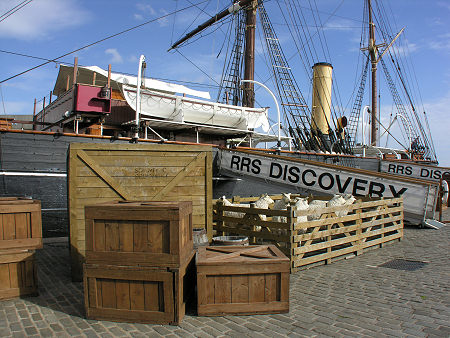 Cargo Ready to be Loaded |

|
|
|
Visitor InformationView Location on MapSTB 5 Star Visitor Attraction Discovery Point, Discovery Quay, Dundee, DD1 4XA. Tel : 01382 309060. Grid Ref: NO 404 298 RRS Discovery Opening Hours Admission Accessibility What3Words Location: ///farm.practical.glaze |
 The Rigging from the Deck |
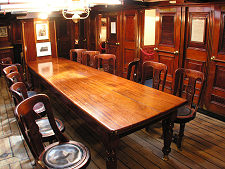 Wardroom |
 Scott's Cabin |
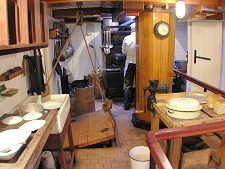 Galley/Sickroom |
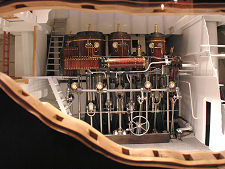 Cutaway Model Showing Engine |
